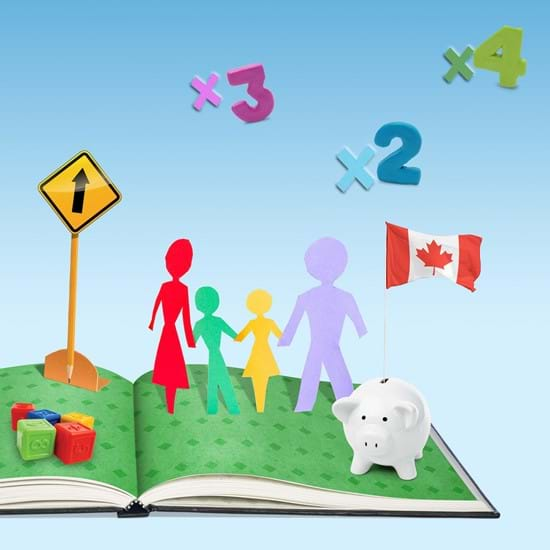
Save Now and Capitalize on a Sunny Future
Savings, money under the mattress, a financial cushion, a rainy-day fund, no matter what you call it, having savings is the first step toward financial stability. Knowing that the majority of adults will face financial difficulties at least once in their lives, putting money aside is something to consider seriously. Regardless of your yearly income, it is crucial that you have reserve funds in order to be ready for any hard blow or major life change that may befall you. If you haven’t started economizing yet, it’s time to get on it.
5 Good Reasons to Save
If anything unexpected comes up or, for one reason or another, you’re faced with a significant expense, having an easily accessible sum of money at your disposal will prevent you from having to make a quick, emergency loan. These quick loan services charge very high interest rates, and often high administrative fees also.
Having an emergency fund available to you will allow you to be ready for hardships and will tide you over until your situation gets back to normal. No doubt, the impact of the problematic situation won’t be less difficult to deal with, but thanks to your savings, you won’t feel completely strapped, and you may have a few months’ grace period to rectify the state of your financial affairs. That’s why the recommendation is to set aside 10% of your monthly income in an easily accessible savings account.
Here are 5 good reasons that should inspire you to start saving right away:
1. Prepare for the unexpected
Divorce, health problems, loss of employment, or any other serious, unexpected occurrence could cause your household revenue to drop drastically overnight. Having a safety cushion enables you to adjust to a new situation more easily.
2. Set goals
As the French author Antoine de Saint-Exupery said: “a goal without a plan is just a wish”. Money is often what holds us back from carrying out the projects that lead to the realization of our goals. Therefore, if there are any goals that mean a lot to you, saving up for them allows you to start planning towards them. The plan and project will become more concrete as your savings start to grow.
3. Envision the future with serenity
Life is full of surprises, and we never know what tomorrow will bring. However, there are certain things that we can anticipate. Important expenses like buying a house, going on a vacation, or your childrens’ education must be planned for in advance.
4. Ensure your peace of mind
Lacking the funds to cover unexpected expenses can be extremely stressful. Having a little safety cushion allows you to sleep like a baby and to deal with unpleasant surprises with a cool head. You can’t put a price on peace of mind!
5. Make your money grow
You’re building up your savings month after month, and they’re generating interest. Thus, you are making your money grow and your savings are becoming profitable in the long term. Basically, your nest egg is producing hatchlings. Be sure to put your money in a savings account that offers a significant interest rate, and that your money is easily accessible. A good example of such an account is a TFSA.
What Are the Benefits of Saving?
By making deposits into your savings account on a regular basis, you’ll ultimately have enough saved to do with it as you wish: realize a future goal, secure a good future for your kids, or even use it to see you through hard times. There exist numerous savings products in the province of Quebec that cover: housing, retirement, studies, and even disability. What better way to put your mind at ease than knowing that you are fully prepared for the unexpected?
We have all seen the serious, economic impact that the sudden arrival of COVID-19 has had all around the world. This certainly bolsters the case that having an emergency fund is extremely important if we don’t want to find ourselves in an impossible situation. Businesses have had to close their doors, many people lost their jobs, and supply-chain problems have caused the price of consumer goods to climb significantly. Some situations are simply not possible to anticipate and that’s why it is so important to save while we can.
Unfortunately, when things are going well, we often tend to imitate Aesop’s fabled grasshopper, and choose to believe that they will remain that way. But let’s not forget that the ant, in that same fable, was much better prepared when winter arrived.
The Registered Education Savings Plan (RESP) is a great way to save for a bright future for your child or grandchild. Want to find out more? Make an appointment with one of our representatives today!
Investments as Effective Savings Strategies
The debt ratio of Canadians* has reached 171%. This means that for every dollar of a household’s disposable income, $1.71 must be reimbursed. It is important to note, however, that it does not benefit the government that Canadians be over-indebted, in fact, it’s quite the opposite. The better the financial health of Canadians, the more they purchase, and consequently, the stronger the Canadian economy. That’s one of the reasons why the government of Quebec offers their citizens a variety of very beneficial savings investment options. Some of these, such as the RDSP (Registered Disability Savings Plan) or the RESP (Registered Education Savings Plan) allow you to also benefit from government grants that contribute to your capital. In the case of the RDSP, the government contributes a Canadian Disability Savings Grant of 300%, 200%, or 100% depending on the household income. Over the course of a year, an RDSP can receive an amount of $3,500, and can go up to a ceiling of $70,000 for life. In regard to the RESP, the CESG (Canadian Education Savings Grant) yields 20 to 40% of the annual contribution to all RESPs for an eligible beneficiary, and up to a ceiling of $7,200 per beneficiary, for life. This impressive amount undoubtedly serves as a strong motivator to save up for your kids’ post-secondary education. What’s more, the QESI (Quebec Educational Savings Incentive) can also add to these amounts, provided simply that you request it from Revenu Quebec. These savings plans also provide fiscal benefits because the money you invest is not taxable. It will be taxable once it is withdrawn, though.
However, before you dive headlong into saving, you’ll have to examine your financial situation carefully. In fact, it isn’t always easy to find money to put aside after having bought groceries, paid the rent, the bills, and all the rest! To help you take the initial steps toward saving, there are certain tools available, like the Budget Planner that the Canadian Government has made available, or the Family Budget Tool, especially created for Kaleido clients. These tools will help you to shine a light on your current financial situation, and to make the best choices in order to save effectively in the short, medium, and long term.
How to Save on a Limited Budget
Ideally, financial experts recommend putting 10% of your monthly income aside in a savings account. That said, it isn’t always possible, or realistic, for mid or lower income households to do so. Be that as it may, do the best you can according to your means. $50 per week, or every two weeks, is an excellent start. You’ll be able to save more when your income permits. Even if it seems like a small amount, it will increase monthly, and will end up being a nice little nest egg after a few years.
It’s better to save a bit than not at all!
A Few Tips for Saving Money on a Daily Basis
-
Write Out a Budget
Going through the exercise of writing out your budget by hand often allows you to realize exactly how you spend your money, and to identify the types of purchases that are more superfluous and that could be reduced, or even completely eliminated. A budget also allows you to arrive at an amount that you can put aside at the start of the month.
-
Bring Your Own Lunch and Coffee to Work
It doesn’t seem like much, but the few dollars that you spend daily on lunch or coffee add up to a significant amount by the end of the month. Just add it up and you’ll see. This same amount could easily be put aside for something more important.
-
Opt to Pay with Cash Rather than Credit or Debit Card
It may seem drastic but leaving your credit card at home when you go shopping can help you save quite a bit. Calculate how much you can spend for the week and withdraw that amount. This will allow you to have better control of your money and it will prevent you from impulse buying.
-
Plan Your Meals Before Grocery Shopping
Knowing exactly what items you need, and in what quantity, will prevent you from buying any unnecessary products and from having to throw out any surplus at the end of the week. Making a list (and sticking to it) before grocery shopping is an excellent way to economize every week.
-
Plan Your Menus Around Weekly Specials
Grocery stores offer different discounts every week. Planning your purchases according to those discounts is an excellent way to control your grocery expenses, and once again, to avoid buying unnecessary products that you will end up throwing out.
Would you like to know more about the family support we offer with your RESP? You could benefit from advice and tools to help you manage your finances optimally! Find out more now 🙂.
How to Save Effectively
Choosing the right strategy for saving is not an easy decision and depends on several factors, but rest assured, there are numerous tools and resources available to help you get started.
Identify your needs
What goal(s) are you saving toward? The answer to this question will allow you to sort through the myriad of available savings plans, and to choose the savings investment options that best correspond to your needs.
To this end, you will need to know, in detail, the ensemble of your expenses. The best way to find out is to list, one by one, all of your recurrent expenses objectively and honestly. Don’t leave anything out: the bottle of wine for Saturday evening or the weekly lunch with colleagues must be included on your list so that you may have the most accurate picture of your monthly expenses.
This exercise will allow you to see how much you are left with after all of your expenses have been covered, and in turn, to decide on the amount to put aside on a regular basis toward your savings. Think about this quote by Warren Buffet: “Do not save what is left after spending; spend what is left after saving”. If, as a result of carrying out this exercise, you realize that you are spending more than you earn, or that you don’t have enough left over for your savings, it may be time to rethink your budget. It may be necessary to cut back on your expenses, and perhaps to adjust your budget to be more realistic and in line with your income.
Decide on the frequency and amount of your contributions
Here again, the possible strategies are numerous: you could either make regular contributions (monthly, bimonthly, etc.) of a fixed amount, or you could contribute any amount you wish at any time of your choosing.
In the case of a Kaleido RESP, for example, you can choose from among various configurations that allow you to prepare for your child’s postsecondary education at your own pace. Before making your decision, you can even use Kaleido’s RESP Calculator to help you arrive at the amount to contribute according to the total amount you wish to amass for your child’s studies.
Having savings is definitely the key to being financially sound, envisioning the future with peace of mind, and most importantly, it is possible for everyone. Regardless of your goals or financial situation, there is a savings plan available for each and every one to realize their goals or to deal with life’s ups and downs. The important thing is not to put off saving, and to start putting money aside as soon as possible.
Don’t hesitate to consult a financial adviser who can help you find the best saving strategy according to your current financial situation. The advice of a professional can help you to simplify saving, and to invest well.
*This statistical item was taken from a study published in Les Affaires in December 2020



